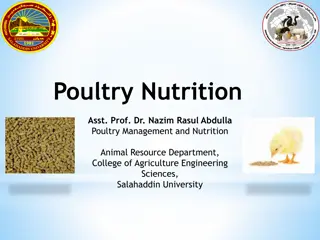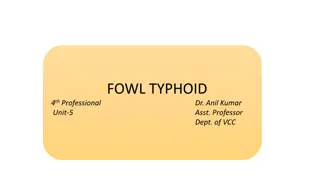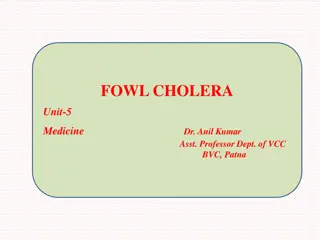Understanding Fowl Typhoid and Paratyphoid in Poultry
Fowl typhoid is a septicemic disease affecting domestic birds, characterized by acute and chronic phases, enlarged spleen, bronzy-colored liver, and diarrhea. It is caused by Salmonella gallinarum and is very lethal, with mortality reaching 75% in untreated flocks. The disease shares similarities with pullorum disease and requires careful diagnosis for differentiation. Laboratory tests like bacterial cultivation and serological tests are crucial for accurate identification. Paratyphoid infections and fowl cholera also show resemblances, emphasizing the importance of distinguishing markers like liver and spleen abnormalities.
Download Presentation

Please find below an Image/Link to download the presentation.
The content on the website is provided AS IS for your information and personal use only. It may not be sold, licensed, or shared on other websites without obtaining consent from the author. Download presentation by click this link. If you encounter any issues during the download, it is possible that the publisher has removed the file from their server.
E N D
Presentation Transcript
poultry diseases 1 (xpkkoju) fourth stage chapter two bacterial Diseases- lecture 7 Fowl Typhoid+ Paratyphoid Paratyphoid Dr.Harith Abdulla Department of Pathology and Poultry Disease College of veterinary medicine university of basrah University of Basrah- College of veterinary medicine- Department of Pathology and Poultry Disease
Fowl Typhoid is a septicemic disease of domestic birds, characterized by an acute and chronic phase , enlarged spleen , bronzy colored liver, and diarrhea with pasty vent. Etiology Etiology : : Salmonella gallinarum Susceptibility very susceptible. Susceptibility :Young and adult chickens are
1- Incubation period 4-5 days. 2- Course of disease about 5 days. 3- High fever. 4- Greenish diarrhea. 5- Mortality 75% in untreated flocks. 6- Comb and wattles : Pale and shrunken , in acute cases appeared dark.
1- Liver :Enlarged 2-3 times, bronzy color. Necrotic foci is evident in some cases. 2-Spleen :Enlarged 2-3 times of normal size, mottled, sometimes hemorrhagic. 3-Kidney :Enlarged, hard swelling and congested. 4-Oviduct :Appeared cooked. 5-Hemorrhagic ova,misshapen and discoloration. 6-Necrotic foci in the heart. 7-Intestine :Catarrhal inflammation. 8-Grayish-white foci may be observed in lungs, heart and gizzard.
Diagnosis Diagnosis: Similar to pullorum disease.
There are similarities with Pullorum Disease, Paratyphoid Infections and Fowl Cholera. For differentiation: 1-The marked congested and grossly enlarged liver and spleen. 2-Laboratory diagnosis. A-Cultivation and identification of the bacteria. B-Serological test : Agglutination test.
A large group of acute or chronic diseases caused by one or more of the motile members of the genus Salmonella. Etiology : There are about 1.700 serological types of motile salmonellae. Susceptibility: This is a group of diseases which have public health Importance. Etiology : Susceptibility:
1- Rodent, reptiles and flies are the source of infections in the chicken houses. 2-Egg shell transmission ( Horizontal ). 3-Contaminated environment, hatchery, feed, water, litter and animals by products.
A- Young chicks: As in: Pullorum Disease and Fowl Typhoid. B B- - In adult : 1-Adults do not exhibit signs of infection .There are chronic carriers of paratyphoid organism. 2-Mortality is low. In adult :
Post As in Pullorum Disease and Fowl Typhoid. Post- -mortem lesions: mortem lesions: Diagnosis, Control, AS In Other Salmonella Infections. Control, Prevention, AND Treatment: AND
1-Elimination of the carrier. 2-Start with Salmonella free flocks. 3-The hatchery should be cleaned after each hatch. 4-Fumigation between each hatch: KMNO4 one part + 2 volume Formalin. 5-Fumigate at 18 days of incubation for 1-3 hours. 6-Pre-incubation fumigation may be applied. 7-Blood testing breeders. The most important method. :























